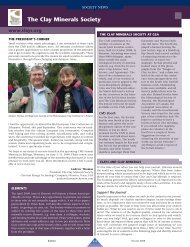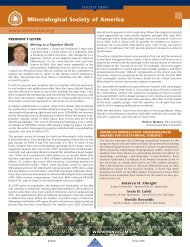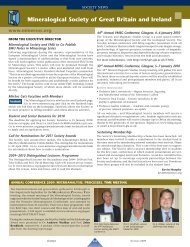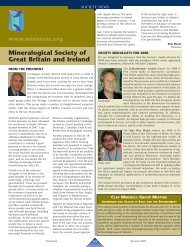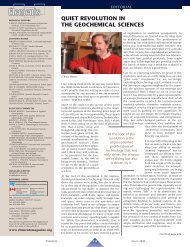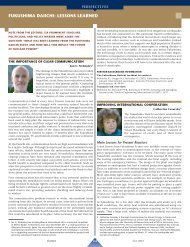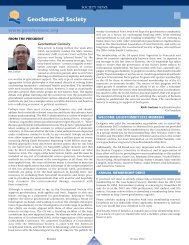The Clay Minerals Society - Elements Magazine
The Clay Minerals Society - Elements Magazine
The Clay Minerals Society - Elements Magazine
- No tags were found...
You also want an ePaper? Increase the reach of your titles
YUMPU automatically turns print PDFs into web optimized ePapers that Google loves.
www.clays.org<strong>The</strong> <strong>Clay</strong> <strong>Minerals</strong> <strong>Society</strong>THE PRESIDENT’S CORNER<strong>The</strong>se days the quickest way for anyonewishing to obtain information about almostanything is to use the Internet, and soanyone wanting to find out what <strong>The</strong> <strong>Clay</strong><strong>Minerals</strong> <strong>Society</strong> is and what it does will firstfind their way to the <strong>Society</strong>’s website, www.clays.org. Consequently it is vital that ourwebsite be easy to use and kept up to date.<strong>The</strong> CMS website was re-designed a coupleof years ago, and renewed efforts have been made recently to updatethe information on its numerous pages. This is no easy task, and anumber of members have contributed to pages relevant to their responsibilities.<strong>The</strong> co-ordinator of the information is the new Chair of theCommittee on Electronic Communication, Covadonga Brime(University of Oviedo), and the technical changes are made by ourwebmaster Gordon Nord at the <strong>Society</strong>’s office. Please visit the website,where you will find a lot of useful information on all the activities ofthe <strong>Society</strong>. If you see anything that needs to be updated, please contactCovadonga at brime@geol.uniovi.es.I hope you find the accompanying article about Haydn Murray as fascinatingas I did. Haydn has had an extremely interesting life, muchof it involved with an incredible variety of applications of clays, andhis breadth of knowledge of clays is unsurpassed. He is a much respectedfather figure in CMS – he has made many valuable contributions to the<strong>Society</strong> and hopefully will continue to do so for many years yet.Finally, congratulations and grateful thanks to Editor-in-Chief JoeStucki and Managing Editor Kevin Murphy for the massive amount ofwork they accomplished in producing one of the largest volumes of<strong>Clay</strong>s and <strong>Clay</strong> <strong>Minerals</strong> in many years. Volume 57 for 2009 contained71 papers in 822 pages.THE SOURCE CLAYS REPOSITORYDerek BainPresident, <strong>The</strong> <strong>Clay</strong> <strong>Minerals</strong> <strong>Society</strong><strong>The</strong> Macaulay Institute, Aberdeen, UKd.bain@macaulay.ac.ukEven in relatively “pure” clay deposits, the assemblage of minerals andtheir compositions can change significantly within a few centimeters.In the early 1970s, the <strong>Clay</strong> <strong>Minerals</strong> <strong>Society</strong> recognized the need fora collection of clays from which researchers could obtain identicalsamples from a large stock of homogenized material. Largely throughthe leadership of William F. (Bill) Moll at Georgia Kaolin Company,but with the support of many individuals in the clay minerals industryand the <strong>Clay</strong> <strong>Minerals</strong> <strong>Society</strong>, the Source <strong>Clay</strong>s Repository shipped itsfirst materials in early 1973. <strong>The</strong> Repository was originally housed atthe University of Missouri but moved to Purdue University (Indiana,USA) in August 2002, where it currently resides.<strong>The</strong> Source <strong>Clay</strong>s Repository contains two types of materials, the Source<strong>Clay</strong>s and the Special <strong>Clay</strong>s. <strong>The</strong> Source <strong>Clay</strong>s consist of 8 differentmaterials (KGa-1b, KGa-2, PFl-1, SHCa-1, STx-1b, SWy-2, Syn-1, andSAz-1) available in 125 or 250 gram units. For each Source <strong>Clay</strong>, sufficientraw sample was collected to provide one metric ton of processedmaterial. Each sample was dried at low temperature, homogenized, andpulverized, and then stored in polyethylene bags. SAz-1 is currentlydepleted, but it is planned to obtain additional material this comingsummer. <strong>The</strong> Special <strong>Clay</strong>s consist of materials that have not beenDr. Gnanasiri (Prema) Premachandra (right) andChelsea Page (left) pose in front of some Source<strong>Clay</strong>s ready for shipment. Prema manages the dayto-dayoperation of the Source <strong>Clay</strong>s Repository,while Chelsea, a student worker, handles packagingand shipping.homogenized. Since themove to Purdue, theRepository has shipped6159 units to countriesthroughout the world.<strong>The</strong> Repository alsohouses the bentonite collectionof the late Prof.Ralph E. Grim, which wasdonated by Prof. NecipGuven. T he Gr i mCollection consists ofabout 360 samplesranging from a few gramsto almost a kilogram of material. <strong>The</strong> Grim Collection is available toresearchers who wish to utilize a significant number of the samplesfrom the collection in their research.More information about the Source <strong>Clay</strong>s is available on the <strong>Clay</strong><strong>Minerals</strong> <strong>Society</strong> website (www.clays.org).HAYDN HERBERT MURRAY –2009 PIONEER LECTURERDarrell SchultzOnce upon a time on a farm nearKewanee, Illinois (USA), a brighthigh school senior, who was alsoa pretty good football player, hada particularly inspiring scienceteacher. This teacher took hisclass on a field trip to a nearbycoal mine. Our bright highschool senior was impressedenough with the operation thathe decided he wanted to be amining engineer. Among the schools interested in him as a footballplayer, one emphasized the quality of their Department of MiningEngineering—the University of Minnesota. In 1942, the young manchose this as the place to pursue his interests.Haydn Herbert Murray enrolled in college just before turning 18 yearsold, when he became eligible for the military draft as World War II wasin full swing. He completed two semesters and half of the springsemester before entering the Army. Prophetically, he was shipped toCamp Wheeler, Georgia. At the time, he did not realize that the landon which Camp Wheeler was located was actually owned by GeorgiaKaolin Company but had been assigned to the U.S. Army under “eminentdomain” until 1947. Fifteen years later he joined Georgia KaolinCompany.After his basic infantry training was completed, the Army sent him tothe Army Specialized Training Program of the University of Alabamato study basic engineering subjects, one of which was geology, whichhe particularly liked. Later this interest was reinforced in the Philippines,where he worked with volcanic ashes and soils while building airstripsand roads. At the University of Alabama, he applied to the OfficerCandidate School at Fort Belvoir, Virginia, and was accepted. He graduatedfrom OCS on December 12, 1944. He had been told that he wouldprobably be in the United States for at least six months. With this news,he married his high school sweetheart, Juanita Ara Appenheimer, on<strong>Elements</strong> 116April 2010
December 16. Eleven days later he was ordered to report to Fort Lewis,Washington. When he checked in, the desk sergeant said, “Lt. Murray,you are alerted for immediate overseas duty.” He boarded a troop shipin Oakland, California, on February 5, 1945. When he arrived in NewGuinea, he was assigned to the 856 th Engineer Aviation Battalion onthe island of Biak*, which is 50 miles north of New Guinea and 50miles south of the equator. After duty on Biak, the battalion was sentto the Philippines to repair and refurbish the airport at Nichols Fieldon Luzon near Manila.After being discharged in August 1946, Haydn used the G.I. bill benefitsto enroll at the University of Illinois, where he received threegeology degrees in just five years. After completing his master’s degreein igneous petrology, he accepted a fellowship funded by Illinois <strong>Clay</strong>Products and offered to him by Dr. Ralph Grim. He says, “It was oneof the best moves I ever made.” Grim had transferred to the GeologyDepartment in 1948 after a 16-year career at the Illinois GeologicalSurvey, so Haydn became Grim’s first PhD student and a clay mineralogist.His dissertation was titled “<strong>The</strong> Structure of Kaolinite and ItsRelation to Acid Treatment.” In 1951, Grim recommended Haydn for afaculty position at Indiana University and for appointment as the claymineralogist at the Indiana Geological Survey.During his first year of teaching, Haydn attended the first Conferenceon <strong>Clay</strong>s and <strong>Clay</strong> <strong>Minerals</strong> at the University of California, Berkeley.At this meeting, <strong>The</strong> <strong>Clay</strong> <strong>Minerals</strong> Committee was formed, with RalphGrim as chairman. <strong>The</strong> National Academy and the National ResearchCouncil supported the <strong>Clay</strong> <strong>Minerals</strong> Committee for the next 12 years.At the 11 th meeting of the group, in Ottawa, Canada, the NAS-NRCproposed that the <strong>Clay</strong> <strong>Minerals</strong> <strong>Society</strong> be formed, and the <strong>Clay</strong><strong>Minerals</strong> Committee appointed Richards Rowland from Shell Oil, JamesEarly from Gulf Oil, and Haydn Murray to charter <strong>The</strong> <strong>Clay</strong> <strong>Minerals</strong><strong>Society</strong>, which was accomplished on July 18, 1962, as a 501(c)3-taxexemptorganization.In 1957, Haydn resigned his positions at Indiana University and theIndiana Geological Survey to become the Director of Research andDevelopment at Georgia Kaolin Company. What attracted GeorgiaKaolin to Haydn was his work on factors that influenced the viscosityof kaolins at 70% solids. At Georgia Kaolin, he hired a first-rate groupof clay mineralogists and chemists: Wayne Bundy, Robert Conley, JackHarrison, William Moll, Colin Harvey, Andy Torok, Joe Weiss, and TomThompson. This group developed several new products for papercoating and filling, paint, ceramics, plastics, and other uses.Haydn’s career at the Georgia Kaolin Company advanced with managerialappointments: Manager of Operations (1961), Vice President ofOperations (1963), and Executive Vice President and Chief OperatingOfficer (1964). In the mid-1960s, Georgia Kaolin expanded throughacquisitions: Benton <strong>Clay</strong> Company, located in Casper, Wyoming;Southern <strong>Clay</strong> Products, in Gonzales, Texas; New Zealand China <strong>Clay</strong>s,in Maungaparerua, New Zealand; and a joint venture with AmbergerKaolin in Hirschau, Germany. <strong>The</strong>se acquisitions gave Haydn an opportunityto learn about the applications of sodium and calcium bentonites,halloysite, and European kaolins. At Georgia Kaolin Company hehad the opportunity to visit and evaluate many large kaolin depositsin Australia, on the island of Belitung in Indonesia, in South Africa,and in Mexico.In 1973, Haydn returned to Indiana University as head of the GeologyDepartment, a position he held until he left the teaching faculty in1984 to focus on research. At Indiana he had an outstanding group ofPhD students: Wayne Bundy, Jack Harrison, Colin Harvey, RobertPruett, Tom Dombrowski, Jessica Elzea-Kogel, Jun Yuan, Roland Merkl,Tim Salter, Karen Keith, and Huitang Zhou. His doctoral students didtheses on kaolins in Saskatchewan and China, halloysite in NewZealand, bentonite in Wyoming, and palygorskites in South Georgia,North Florida, and China. In all, Haydn has 96 theses on his shelf.Haydn’s international work expanded at the same time he returned toIndiana University. In 1973, Haydn chaired the UNESCO Kaolin GenesisCommittee, which was formed by Milos Kuzvart of Czechoslovakia.This group sponsored annual field excursions and conferences to studyand report on kaolin deposits throughout the world. In 1984, he wasasked by the Agency for International Development (AID) of the StateDepartment to evaluate the clay deposits in Egypt. In 1985, he wasasked by the Geological Survey of Chile to visit and evaluate Chileanindustrial mineral operations. After he retired in 1994, Haydn formeda consulting company, H. H. Murray and Associates, whose activitiestook him to kaolinites in Argentina, Australia, Brazil, Canada, andChina; to bentonites in Argentina, Germany, Italy, Great Britain, andthe United States; and to palygorskites in the United States, China, andSenegal.Over the years, various professional organizations honored Haydn. Heserved as president of <strong>The</strong> <strong>Clay</strong> <strong>Minerals</strong> <strong>Society</strong> in 1965; the <strong>Society</strong>for Mining, Metallurgy, and Exploration in 1988; the American Instituteof Professional Geologists in 1991; and the International <strong>Clay</strong> <strong>Minerals</strong>Group in 1993. He was awarded the SME’s Hardinge Award in 1976. Atthe 2000 International <strong>Clay</strong> Conference, he was awarded an HonoraryDoctor of Science degree from the University of Buenos Aires. In 2003,Haydn was elected to the National Academy of Engineering and hereceived the Department of Geology Alumni Achievement Award fromthe University of Illinois. In 2004, he received an honorary Doctor ofScience degree from Indiana University, which especially pleased himbecause it was from his peers. In 2006, he served as vice-chair of thePeer Evaluation Committee in Section 11, Earth Resources Engineeringof the National Academy of Engineers, and two years later he chairedthis committee.Haydn has published over 200 papers, chapters in books, and twobooks; he holds four patents. His latest book, Applied <strong>Clay</strong> Mineralogy(2007), sums up his experience as a productive clay mineralogist for60 years. Looking back, Haydn says there is very little he would change.As Professor Emeritus of Economic Geology, <strong>Clay</strong>s, and Industrial<strong>Minerals</strong>, he plans to continue his activities as long as he is able. Hebelieves the best and highest-quality kaolin deposits are located in theCapim Basin in Brazil, the best sodium bentonites are in Wyoming,and the best calcium bentonites are in Greece, Italy, and Germany. Heis currently involved in the study and development of a large palygorskitedeposit in China. In addition, he is continually working on thekaolins of Georgia and adjusting his ideas on their environment ofdeposition and the effect of postdepositional alteration. Also, he isinvolved in exploration for bauxite with specific alumina, silica, andiron contents in Brazil and Suriname.Combining Walter Keller’s donation of 650 specimens of clays andbauxites with Haydn’s 600 specimens probably makes the IndianaUniversity collection the largest collection of clay minerals anywhere.Haydn has a very well-equipped laboratory for the study of clay minerals,which is now run by David Bish, who holds the Murray Chair ofApplied <strong>Clay</strong> <strong>Minerals</strong>, established by Haydn and Juanita Murray in2001. <strong>The</strong>se facilities give Indiana University an active and ongoingclay minerals program.Dewey Moore and Shelley Roberts*** For an impression of what life was like for Haydn in the Pacific during WWII,see www.ibiblio.org/hyperwar/AAF/VII/AAF-VII-10.html.** <strong>The</strong> authors found Wayne Bundy and Jessica Elzea-Kogel’s interview of Haydnin the CMS News (Spring 1998) to be helpful.<strong>Elements</strong> 117April 2010




